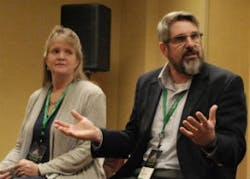Dow’s Janette Brightwell (left) and Michael Carroll of Georgia-Pacific, reported that Open Process Automation promises to enable faster decision-making and increased competitiveness—and to help asset-owners cope with staffing shortfalls and corporate reorganizations.
The quest for plug-and-play networking and interoperable process control envisioned by the Open Process Automation (OPA) Forum is gathering steam and gaining ground, but it still needs more process industry end-user support to bring its interoperable Open Process Automation Standard (O-PAS) into reality.
Janette Brightwell of Dow and Michael Carroll of Georgia-Pacific were on hand at this week’s Schneider Electric Innovation Days in Austin, Texas, to make the case for the broader participation of asset owners across industry, and to explain why these industry leaders in material science and pulp & paper had signed on to the effort. They were joined for brief presentations and a subsequent panel discussion by Bradley Houk of ExxonMobil and Trevor Cusworth of Schneider Electric.
"ExxonMobil's vision is for a standards-based, open, secure and interoperable process control architecture that promotes innovation and value creation," said Houk, senior engineering advisory, automation and process control, ExxonMobil Research & Engineering. "The key characteristics of Open Process Automation include industry-standard interfaces and networks, interoperable hardware, best-in-class hardware and software components, open software access, designed-in security, and portable end-user software.” However, most process automation software today still isn't portable between different generations of a supplier’s systems, much less among different supplier’s automation platforms.
"In a truly open system, anyone can write software if it complies with the standard,” Houk said. “A successful Open Process Automation effort will support application reuse, increase value creation, enable continuous innovation, solve system integration issues, design in security, empower workforces, and reduce total cost of ownership. We want this because we believe it will drive value capture."
Partners to test open products
While ExxonMobil is one of OPAF's founding members, it's also conducting an independent research program to develop a proof-of-concept and test bed, which will be used to evaluate Open Process Automation methods and for the direct development of deployable products; encourage other users to participate in OPAF as collaborating partners; select standards for inclusion in O-PAS's "standard of standards.”
Houk reported the test bed will be designed and built by ExxonMobil and other user partners in 2019-2020, with field trials scheduled for 2021. Current asset-owner partners include Aramco Services Co., BASF, Conoco Phillips, Georgia-Pacific, Dow Chemical Co. and Linde.
"The collaboration partners are selecting additional system integrators; using O-PAS standards as available; conducting multiple, parallel field trials; and sharing non-competitive learnings among the other partners," explained Houk. "We're still talking with other users about joining as collaborative partners. This is important because, while they won’t be sharing competitive information, they will be sharing with each other how potential Open Process Automation components are working, and what performance gaps need to be addressed. Likewise, test bed results will be shared with the OPA Forum."
OPA aids ops, calms reorgs
Michael Carroll, vice president of innovation for Georgia-Pacific, added that the potential value of Open Process Automation goes beyond simply enabling plug-and-play networking and process control to help process manufacturers with other major issues.
"We and other companies are facing a lot of retirements now and in the near future. And if there's no one available to run these advanced applications, we’re looking a 25% hit in terms of productivity,” Carroll said. “So, as early as 2007 we realized that we had to do something differently.”
He pointed to the meager 1-2% annual productivity improvements experienced by GP and other leading industrial companies, attributing the pace of progress primarily to the company’s internal processes. “Turns out it takes us a year to make a decision, and 18 months to implement it,” Carroll said. But if the company can use new tools such as data analytics to make decisions in six months rather than 12, productivity gains jump to 4-5% per year.
"Because we must make decisions faster to compete, we realized the Georgia-Pacific and other process industry companies can't survive if we don't do Open Process Automation. It's going to give participants an accumulated advantage over those that don't do it, so we say let's start learning now."
Likewise, Janette Brightwell, process automation migration program technical leader, Dow Chemical Co., reported that OPAF and the O-PAS standard are expected to help her company deal with its recent reorganization into three operating companies.
"Our material science company wants to become the most customer-centric and sustainable in the world. This is a big challenge, but we see Open Process Automaton as the future of process automation and control, and believe those that don't do it will be left behind," said Brightwell. "Dow has been an innovator in process automation for many years, and even developed our own proprietary process automation system years ago. We captured some gains that can still be useful, but we also had to shoulder the burden of maintaining it.
"One of the benefits of joining OPAF is that it allows participants to share the load of developing, building and maintaining new process control capabilities and solutions without having to carry the whole load themselves. This benefit is even more useful to us lately because of all the different kinds of control platforms we're facing as a result of recent mergers, acquisitions and divestitures."
"We still have a large installed base of control systems that are migrating to commercial platforms, and we're making good headway,” Brightwell said. “However, migrating using components enabled by Open Process Automation could be very helpful, which is why it's so attractive to us."






